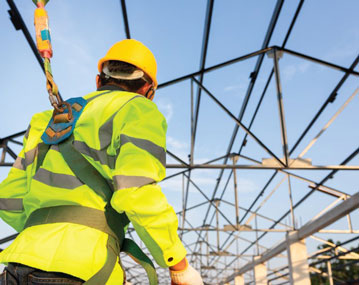There are various ways to reduce the risks of common workplace accidents. Here are seven ways to mitigate these potential hazards.
By Kerryn Ramsey
While there’s a risk that workplace hazards may become dangerous, costly and even life-threatening, there are various ways to mitigate the risks.
“Just stop and think about what you’re about to do,” says Naomi Kemp, chair of the Australian Institute of Health and Safety (AIHS). “You need to ask yourself, ‘How do I prevent it from going wrong?’ and act accordingly.”
The AIHS is dedicated to enabling safe, healthy people in productive workplaces and communities. It advocates for contemporary government policy as well as internal company policy.
Here are the seven most common workplace hazards and what you can do to reduce the risk of serious accident.
- HAZARDOUS CHEMICALS
Hazardous chemicals can have an immediate effect, such as burns or poisoning, or a long-term impact on health such as cancer and damage to lungs. They can also be corrosive, flammable and cause great environmental damage if spilled.
“The best way to mitigate risk is to fully understand the PPE and emergency requirements of the specific chemical,” says Kemp. “You must know how to protect yourself whether it’s a liquid, gas or dust. Each chemical has a different set of protocols.” All the relevant information is contained in the safety data sheet (SDS), included when the chemical is purchased.
- FAILURE TO IMPLEMENT SAFETY PROCEDURES
Safety procedures are reasonable instructions put in place to protect workers and others. Of course, for these procedures to work efficiently, they need to be implemented. Whether it’s wearing PPE, using guarding or obeying exclusion zones, the responsibility is on the worker to follow the instructions.
Signage is also a procedural control for specific hazards and jobs. It can be information about operating a forklift in an area or wearing specific PPE.
“The responsibility is on the worker to comply with instructions given, and failure to do so is a legal risk,” says Kemp. “Simply put, most safety procedures enable legal compliance.”
- FORKLIFT RELATED HAZARDS
Operating a forklift or any type of moving vehicle such as a crane or excavator, is referred to as mobile plant operation. You need to be licensed to operate the equipment and a high-risk licence is often required. This is heavy equipment that can do major damage if operated incorrectly.
“In construction, manufacturing, agriculture and warehousing, the highest number of fatalities and serious injuries relate to people and pedestrians interacting with a mobile plant,” says Kemp. “While licensing to operate these machines is essential, competency also needs to be taken into account.”
Competency comes from experience and includes a knowledge of the plant’s capability and limitations.
- ELECTRICAL CORDS
Despite the increased use of batterypowered tools, electrical cords and extension leads are an integral part of worksites. The danger here is that anything related to electricity can be potentially fatal.
“Each cord should have a visual inspection before use to ensure it’s not frayed or damaged,” says Kemp. “It should also be plugged into a residual current device (RCD). If something does happen, the RCD isolates the power and limits the impact of the shock.”
Placement of the cords needs to be considered so they are not a tripping hazard and are well away from any water.
- CLUTTER
Unnecessary clutter can block exits—a tragedy waiting to happen in an emergency—as well as obstruct sight lines and create tripping hazards. It can have a negative impact on efficiency, production and safety.
“Clutter needs to be dealt with proactively,” says Kemp. “It’s a matter of cleaning up as you go. A lot of this material is combustible which adds a whole other level of danger. Segregating waste and moving it from the site in a timely manner is the best and most efficient way to reduce risk.”
- WORKING AT HEIGHTS
Working at heights is an inherently dangerous activity and all safety procedures must be followed. “Harnesses only work if you fall,” says Kemp. “When working at heights, you want a solution that will prevent you from falling.”
The solution might be a scissor lift in which you stay inside. If you’re working on a roof, anchor points and lanyards should limit you from getting closer than two metres to the building edge.
“If a job requires work at the edge of the building, a higher order of control is required with edge protection and a harness capable of effective fall arrest,” says Kemp.
- HAZARDOUS MANUAL TASKS
Hazardous manual tasks are jobs that require lifting or moving heavy items or putting your body in uncomfortable positions. The way you lift, the repetition, and the size and weight of the object should be carefully considered. While this type of work can have an immediate impact, there’s also a long-term effect.
You probably won’t notice the stress on your body if under the age of 25 but aches, pains and complications can arise by the time you’re 40.
“To save yourself from future injury, reduce the forces on your body and try to avoid awkward or sustained postures,” says Kemp. “The rate of musculoskeletal disorders in the building and construction industry is very high.”
Use the tools at your disposal—forklifts, cranes, trolleys—to move heavier items around. Ultimately, this will be more efficient and save you from long-term injury.






